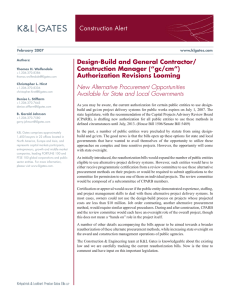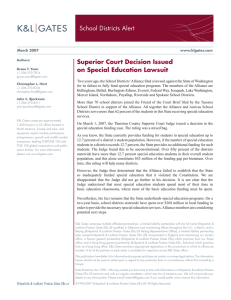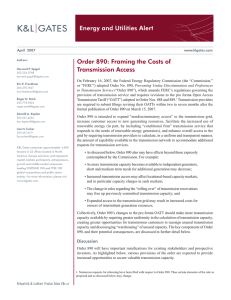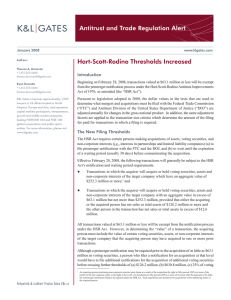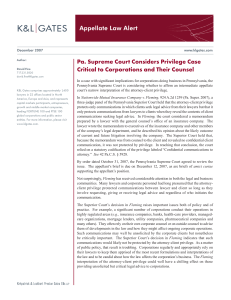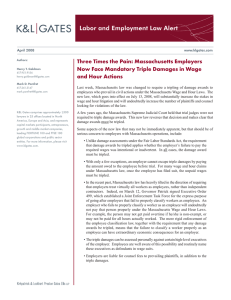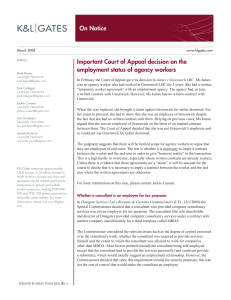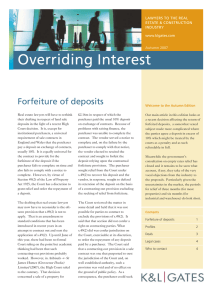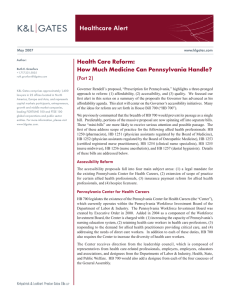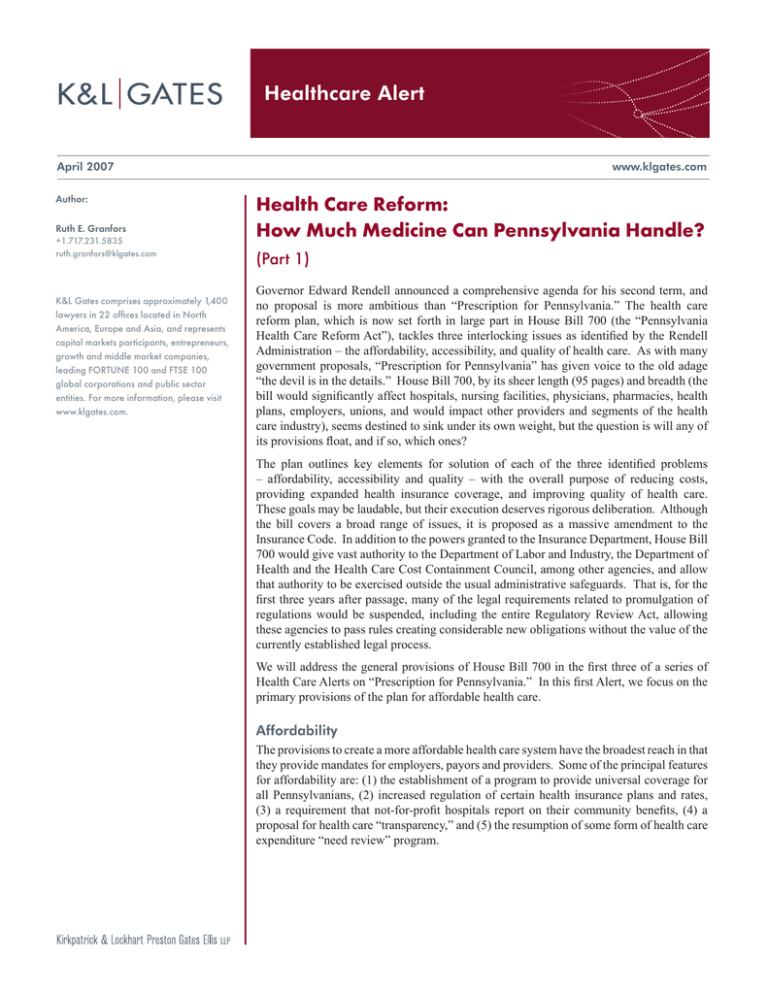
Healthcare Alert
April 2007
Author:
Ruth E. Granfors
+1.717.231.5835
ruth.granfors@klgates.com
K&L Gates comprises approximately 1,400
lawyers in 22 offices located in North
America, Europe and Asia, and represents
capital markets participants, entrepreneurs,
growth and middle market companies,
leading FORTUNE 100 and FTSE 100
global corporations and public sector
entities. For more information, please visit
www.klgates.com.
www.klgates.com
Health Care Reform:
How Much Medicine Can Pennsylvania Handle?
(Part 1)
Governor Edward Rendell announced a comprehensive agenda for his second term, and
no proposal is more ambitious than “Prescription for Pennsylvania.” The health care
reform plan, which is now set forth in large part in House Bill 700 (the “Pennsylvania
Health Care Reform Act”), tackles three interlocking issues as identified by the Rendell
Administration – the affordability, accessibility, and quality of health care. As with many
government proposals, “Prescription for Pennsylvania” has given voice to the old adage
“the devil is in the details.” House Bill 700, by its sheer length (95 pages) and breadth (the
bill would significantly affect hospitals, nursing facilities, physicians, pharmacies, health
plans, employers, unions, and would impact other providers and segments of the health
care industry), seems destined to sink under its own weight, but the question is will any of
its provisions float, and if so, which ones?
The plan outlines key elements for solution of each of the three identified problems
– affordability, accessibility and quality – with the overall purpose of reducing costs,
providing expanded health insurance coverage, and improving quality of health care.
These goals may be laudable, but their execution deserves rigorous deliberation. Although
the bill covers a broad range of issues, it is proposed as a massive amendment to the
Insurance Code. In addition to the powers granted to the Insurance Department, House Bill
700 would give vast authority to the Department of Labor and Industry, the Department of
Health and the Health Care Cost Containment Council, among other agencies, and allow
that authority to be exercised outside the usual administrative safeguards. That is, for the
first three years after passage, many of the legal requirements related to promulgation of
regulations would be suspended, including the entire Regulatory Review Act, allowing
these agencies to pass rules creating considerable new obligations without the value of the
currently established legal process.
We will address the general provisions of House Bill 700 in the first three of a series of
Health Care Alerts on “Prescription for Pennsylvania.” In this first Alert, we focus on the
primary provisions of the plan for affordable health care.
Affordability
The provisions to create a more affordable health care system have the broadest reach in that
they provide mandates for employers, payors and providers. Some of the principal features
for affordability are: (1) the establishment of a program to provide universal coverage for
all Pennsylvanians, (2) increased regulation of certain health insurance plans and rates,
(3) a requirement that not-for-profit hospitals report on their community benefits, (4) a
proposal for health care “transparency,” and (5) the resumption of some form of health care
expenditure “need review” program.
Healthcare Alert
Universal Coverage
The shining star of the Administration’s plan is the
program “Cover All Pennsylvanians,” or CAP.
Already, however, it is receiving substantial critical
evaluation from the business community.
Currently, the Insurance Department administers the
Children’s Health Insurance Program (“CHIP”), which
is expanding to “Cover All Kids,” a program offered
to uninsured children and teens up to age 19, and the
adultBasic program, which targets uninsured adults
under a certain income level. The CAP program,
which would expand that coverage and replace
adultBasic, would be available to small businesses
employing between 2 and 50 people and certain
eligible individuals. The Insurance Department would
contract with private insurers to supply the standard
benefit package under CAP.
CAP would be funded through a “fair share” tax
assessed against all employers, subject to offset by
certain credits. The tax is set at 3% initially, and at
3.5% after June 30, 2010. Those employers who
already provide “qualifying health care coverage,” as
determined by the Department of Labor and Industry
in consultation with the Insurance Department, would
receive a credit equal to the amount of the tax. Among
other things, the Department of Labor and Industry also
would have responsibility for developing reporting to
administer the fair share tax, enforcing payment and
issuing penalties for failure to file required reports.
The greatest concerns about this aspect of the bill
are: (1) the costs on small employers related to
providing coverage, paying the tax and administering
the requirements of the proposal and (2) whether the
CAP program will be able to sustain itself under the
proposed credits, and if not, whether those credits
will decrease or disappear. In addition, what will
constitute “qualifying health care coverage” is
unknown. One also wonders, because many of the
bill’s penalty and payment provisions feed the CAP
Fund, whether there may be administrative abuses of
these penalty provisions if the CAP Fund is in need of
replenishment.
Regulation of Health Plans and Premiums
These provisions would directly regulate insurers
offering small group health plans and individual health
plans. House Bill 700 requires these insurers to offer
a standard plan with a basic benefit package that is
comparable to the CAP benefits requirements. These
plans would be subject to community rating and rate
increases would need to be approved as outlined in the
proposal. A rate increase could be denied if: (1) the
rate is not actuarially sound, (2) the increase requested
results from inefficient operation by the insurer, (3)
the increase requested “has factored in experience that
conflicts with recognized best practices in the health
care industry,” or (4) the increase results from costs
related to “avoidable hospital-acquired infections and
avoidable hospitalizations due to ineffective chronic
care management.” Thus, this aspect of the bill also
seeks to influence how these plans pay for health care,
and ultimately could affect the plan-provider contracts
and conditions of payment for care. The bill does not
provide definitions for “recognized best practices
in the industry” or “avoidable hospital-acquired
infections.” Furthermore, these provisions would
limit the ability of insurers to include deductible and
cost-sharing components to the standard plan, unless
they would meet certain required conditions.
Not-For-Profit Hospital Community Benefits
Reporting House Bill 700 would require not-for-profit hospitals
to justify their tax-exempt status in a manner different
from the Institutions of Purely Public Charity Act
(“IPPCA,” also known historically as “Act 55”).
These hospitals would be charged with developing
a community needs assessment, to be updated every
three years, and compiling a “community benefits
report” every calendar year. The Department of
Health would have responsibility for establishing
guidelines for the community needs assessment. The
report would be required to identify: (1) the amount
of community benefit that qualifies the hospital for
tax exemption under IPPCA, and (2) the amount of
uncompensated goods and services contributed by
the hospital for that year as recognized under House
Bill 700. The Department of Health could audit
these reports and could disallow certain claims of
uncompensated care reported. Further, hospitals that
calculate actual community benefits at less than the
amount that qualifies the hospital for tax exemption
under IPPCA would be required to pay the difference
to the Department of Health. Thus, there would be
two sets of standards for determining whether notfor-profit hospitals meet criteria to justify their taxexempt status, one set of standards as set forth in
IPPCA and another set of standards established by
the Department of Health. To the extent that the
standards established by the Department of Health
April 2007 | Healthcare Alert
are stricter, i.e., establishing narrower criteria for
substantiating the community benefits, the greater the
payment would be to the Department of Health, which
payments would feed the CAP Fund. Submission of
false or misleading information also could subject the
hospital to additional fines.
Pricing Transparency
The plan for affordability introduces requirements
for “transparency” in health care pricing, which is
intended to allow purchasers and consumers of health
care to make more informed choices about what they
buy. The concern is how to ensure that information
reflected through transparency represents an accurate
picture of price and quality; otherwise, the efforts are
not only burdensome, but meaningless. The proposal
for transparency would require a repository of data:
(1) from hospitals, on payment information for the
150 most frequent admission diagnoses and 150 most
frequently dispensed drugs; (2) from ambulatory
surgical facilities and imaging centers, on payment
information for the 50 most frequent outpatient
procedures; and (3) from retail pharmacies, on
retail price information for the 150 most frequently
prescribed drugs. Substantial debate is expected
on what “information” will be collected; whether
uniformity of reporting will be assured; how the
data would be interpreted, publicized and used; and
whether reporting would take into account certain
outliers or exceptional circumstances. Experience
with reporting (both public and private) has shown
that uniformity of definitions and data reporting is
difficult to achieve. If the information reported is
not uniform, it is essentially useless for comparative
purposes. Despite ambiguities that usually arise
in such reporting programs, House Bill 700 would
authorize fines for noncompliance.
Pennsylvania,” is some form of “need review”
program. Although no one is using the term
“certificate of need,” the Administration’s proposal
references Commonwealth review of “large capital
expenditures.” Such expenditures would not be
approved unless they are “needed” in the community
or region and are “affordable to health care payors.”
It has been suggested that the Administration plans to
address this idea through an Executive Order.
The next Health Care Alert in the series will
address the accessibility provisions in “Prescription
for Pennsylvania.” Information about “Prescription
for Pennsylvania” can be found on the Governor’s
Office of Health Care Reform website: www.rxforpa.
com. House Bill 700 can be found at: http://www.
legis.state.pa.us/.
Questions about health care reform in Pennsylvania,
and how you can get involved, may be directed to:
Public Law and Policy Practice:
Peter A. Gleason 717.231.2892
peter.gleason@klgates.com
Raymond P. Pepe 717.231.5988
raymond.pepe@klgates.com
James D. Welty 717.231.5878
jim.welty@klgates.com
Health Care Practice:
Ruth E. Granfors 717.231.5835
ruth.granfors@klgates.com
Patricia C. Shea 717.231.5870
patricia.shea@klgates.com
Edward V. Weisgerber 412.355.8980
ed.weisgerber@klgates.com
Capital Expenditure Review
One aspect of the affordability plan that is not
included in House Bill 700, but has been addressed
in presentations involving “Prescription for
April 2007 | Healthcare Alert
K&L Gates comprises multiple affiliated partnerships: a limited liability partnership with the full name Kirkpatrick & Lockhart Preston Gates Ellis LLP qualified in
Delaware and maintaining offices throughout the U.S., in Berlin, and in Beijing (Kirkpatrick & Lockhart Preston Gates Ellis LLP Beijing Representative Office); a
limited liability partnership (also named Kirkpatrick & Lockhart Preston Gates Ellis LLP) incorporated in England and maintaining our London office; a Taiwan
general partnership (Kirkpatrick & Lockhart Preston Gates Ellis) which practices from our Taipei office; and a Hong Kong general partnership (Kirkpatrick &
Lockhart Preston Gates Ellis, Solicitors) which practices from our Hong Kong office. K&L Gates maintains appropriate registrations in the jurisdictions in which
its offices are located. A list of the partners in each entity is available for inspection at any K&L Gates office.
This publication/newsletter is for informational purposes and does not contain or convey legal advice. The information herein should not be used or relied
upon in regard to any particular facts or circumstances without first consulting a lawyer.
Data Protection Act 1998—We may contact you from time to time with information on Kirkpatrick & Lockhart Preston Gates Ellis LLP seminars and with our
regular newsletters, which may be of interest to you. We will not provide your details to any third parties. Please e-mail london@klgates.com if you would prefer
not to receive this information.
©1996-2007 Kirkpatrick & Lockhart Preston Gates Ellis LLP. All Rights Reserved.
April 2007 |


